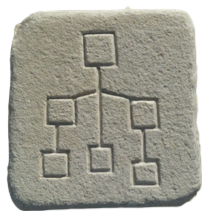Churning the Org Chart is Costly
Creating an organization chart is the foundational act of management.
It records the best way to distribute work among a given set of people with complementary knowledge and skills. That’s what leverage is. When the chart isn’t optimal, the organization isn’t optimized. Nothing is as important to efficiency and margins.
Yet organizations change and change and change their org chart, trying to solve or avoid problems that should be solved differently. Trust breaks down, new silos form, people lose direction. It’s invisibly expensive.
Charts are often changed to avoid personnel issues. Boxes are moved and titles tweaked to work around two executives who can’t get along or to avoid the hard work of integrating units, cultures, and systems.
Let’s First Talk About Power
The chart shows who has authority over whom. Please reflect on the ethical standard of management, The Pledge of Managerial Power.
Fundamental Truths
- Frontline employees want to have only one boss. Getting a new boss is scary.
- Just saying, “It’s a matrix” does nothing to address critical issues of reporting.
- Managers, not employees, must establish workload. See The Dotted Line to Hell.
- No theme—by geography, discipline, or product line—eliminates confusion
- Titles must complement, not confuse the chart.
What an Org Chart Is
- A map of how everyone contributes to mission
- A diagram of reporting and delegation
- A hierarchy of authority (see Pledge)
- A career path
- The web of collaboration
What an Org Chart Isn’t
- A solution to the problems of multiple reporting
- A way to resolve personal conflicts
- A way to break down silosMistake Checklist
- Have we ever used the org chart to avoid a conflict or conflicts?
- Have we rewarded people with titles, instead of responsibilities or compensation?
- Have managers and senior managers broken discipline about reporting structures?
- Do we have hidden power centers?
Let’s do better! See next page.
The Best Practice Checklist
Choose the organization design that’s best for the customer and that’s one you want to grow into, even if you don’t have the right people yet. See Approved Resources at Index 5.2 Organization design for details on these and other schema:
- By discipline
- By geography
- By product line
How to choose? If you sell mostly online, then geography doesn’t matter. But if you sell to and service customers in small territories, then go with the geographic scheme. If you want to sell all product lines to global customers—and if culture differences don’t matter—then organize by management discipline.
Very large organizations often use several themes. Per 4 Week MBA:
“General Motors employs a divisional organizational structure with multiple regional divisions to account for variations in different markets. The divisions include GMNA (North America), GME (Europe), GMSA (South America), GM AMEO (Africa & Middle East), and GMAP (Asia-Pacific).”
Documents (Mostly About Dual Reporting)
The organization chart cannot stand alone. Because of the issues described above, they need several accompanying programs and documents.
- Schedule of Authority, a chart of who can decide what and their spending authority
- Title definitions. Strive for consistency!
- Relationship-building activities, to deal with multiple roles
- Clarify “temporary” reporting roles, i.e., for projects
- Development program (i.e., how to move up the chart)
Chart Design & Maintenance
- Put the customer (or client or patient) at the top
- Include 3-5 descriptors of what each person does
- Include “groups of power,” e.g., a committee of senior managers
- Update it on a regular schedule. It’s OK to update assignments in real time.
Cross-Functional Competence
Development as a manager depends on knowing how different functions and units work together. Use The Index to ask informed and interesting questions of people outside your box. Those conversations become the relationships that can let you be the manager of the next big thing.


